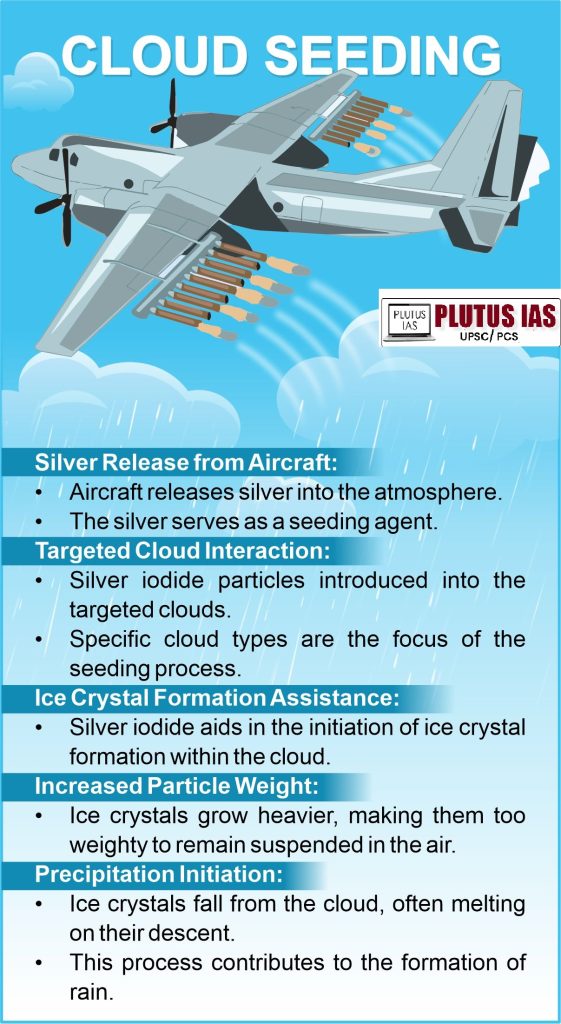26 Apr Heavy rainfall and flood in UAE
This article covers ‘Daily Current Affairs’ and the topic details of ”Heavy rainfall and flood in UAE”. This topic is relevant in the “Environment” section of the UPSC CSE exam.
Why in the News?
In a recent event, the United Arab Emirates (UAE) experienced one of its most significant rainfall occurrences as a result of a severe thunderstorm impacting the region leading to flooding in Urban areas.
Reasons behind extreme Rainfall in UAE
Climate’s Role
Our climate is constantly evolving, and natural variations like El Niño and La Niña can influence extreme rainfall events. Additionally, long-term climate change, driven by factors like greenhouse gas emissions, is impacting global weather patterns. This can lead to conditions that favour intense precipitation.
Warming and the Moisture Connection
As global temperatures rise, more water evaporates from land surfaces, oceans, and other bodies of water. This warmer air acts like a sponge, holding more moisture. Studies suggest that for every degree Celsius increase, the atmosphere can hold around 7% more moisture. When storms develop, this extra moisture translates to heavier precipitation. This can intensify storms by increasing the amount of rain that falls (greater volume), the duration of the downpour (lasting longer), or the frequency of storms in a particular region (occurring more often).
Cloud Seeding
A Targeted Approach: In some regions struggling with water scarcity, cloud seeding is used as a technique to induce rainfall. This method involves introducing materials like silver iodide crystals into clouds. These crystals act as condensation nuclei, around which water vapour condenses more readily, promoting precipitation. Places like the United Arab Emirates, known for its hot and dry climate, have been actively using cloud seeding to increase rainfall.

Understanding Thunderstorms
Thunderstorms are intense weather events characterised by heavy rain, lightning, and thunder. These form due to atmospheric imbalances and turbulence. Warm, unstable air rises rapidly in the atmosphere, encountering enough moisture to form clouds and rain. Upward air currents also play a crucial role. These currents can be triggered by colliding cold and warm fronts, sea breezes blowing from the ocean towards land, or mountains forcing air upwards. As the rising air cools, condensation occurs, leading to the formation of rain clouds and, eventually, heavy precipitation.
About Urban flooding
Urban flooding occurs when excessive rainfall or other factors overwhelm the drainage systems and infrastructure of urban areas, leading to water accumulation on streets, roads, and other urban spaces. This phenomenon poses significant challenges to cities worldwide, impacting infrastructure, property, livelihoods, and public safety.
Causes of Urban Flooding:
Drainage struggles: Outdated drainage systems and clogged pathways can’t handle the water surge.
Pavements: Concrete jungles prevent rainwater from soaking in, increasing runoff.
Location: Low-lying areas and those near water bodies are naturally flood-prone.
Climate Change: More intense storms due to climate change push drainage systems to their limits.
Urban heat: Cities trap heat, fueling storms and worsening downpours.
Climatic pattern of UAE
- The United Arab Emirates (UAE) boasts a desert climate marked by scorching temperatures and minimal rainfall. Situated within the Arabian Peninsula, its location exposes it to extreme heat, especially during the summer months when temperatures often exceed 40 degrees Celsius (104 degrees Fahrenheit).
- The country experiences two distinct seasons: a hot season from May to September and a milder period from October to April. Despite the relatively cooler temperatures in winter, daytime temperatures remain warm, offering a pleasant climate for outdoor activities.
- Rainfall is sparse and irregular, typically occurring between November and April, with most areas receiving less than 100 millimetres annually. The UAE is also prone to dust and sandstorms, particularly during the summer, caused by winds like the Shamal and Khamsin.
- Overall, the UAE’s climatic pattern is characterised by its arid desert conditions, making it a challenging yet intriguing environment shaped by its geographical location and seasonal variations.
Donload plutus ias current affairs eng med 26th April 2024
Prelims practise question
Q1. Consider the following statements regarding the difference between La Nina and El Nino:
- La Niña is defined by abnormally cold ocean temperatures in the equatorial Indian Ocean, while El Niño is marked by unusually warm ocean temperatures in the equatorial Pacific Ocean.
- El Niño negatively impacts the southwest monsoon of India, whereas La Niña does not influence the monsoon climate.
Which of the above statements is/are correct?
(a) 1 only
(b)2 only
(c) Both 1 and 2
(d) Neither 1 nor 2
ANSWER: D
Mains practise question
Q1. In your opinion, should governments invest more in researching cloud seeding technology, considering its potential drawbacks and uncertainties?
I am a content developer and have done my Post Graduation in Political Science. I have given 2 UPSC mains, 1 IB ACIO interview and have cleared UGC NET JRF too.



No Comments